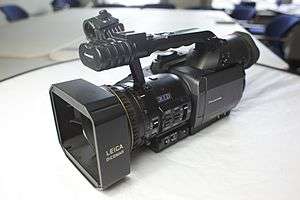Panasonic AG-DVX100

The Panasonic AG-DVX100 was released in December 2002. Its 60 Hz version was the first consumer-affordable digital camcorder capable of recording video at 24 progressive frames per second.[2][3]
The camera was popular among television studios and was popular with independent film makers because of its film-emulating features. Currently the latest and last revision is the DVX100B(E) (2005).[4][5] The camera records to tape, but third party developers have modified DVX100 cameras to dump raw images to a tethered laptop. However, the company most known for doing this, Reel Stream, is no longer operational.[6][7]
Technical specs
Panasonic created a complete line of cameras that support recording in 24p, which is an analog of how film cameras record frames, for independent film production. 24p stands for 24 frames per second progressive: a frame rate which is commonly used in motion picture production, and progressive scan which avoids interlacing to give artifact free frames. These features give the recordings a film quality appearance.
The original AG-DVX100 can shoot in a 4:3 aspect ratio only, the "A" revision added a capability to shoot widescreen video, but it looked squeezed on the built-in monitor. The "B" revision introduced the ability to properly monitor 16:9 aspect ratio. All revisions have CCD sensors with native aspect ratio of 4:3, which causes the decrease of vertical resolution in widescreen mode because of cropping.
The camera was competitively priced below US$4,000. At the time, progressive video was rare for cameras below the US$10,000 price point. In its segment, the DVX100 was rivaled only by the larger shoulder-mount Canon XL-2 which also records progressive video.[8]
The DVX100 contains a 3-CCD image sensor system, with 410,000 (380,000 effective) pixels each with 4:3 native aspect ratio. When shooting widescreen, the sensor is cropped at the top and at the bottom, resulting in significant loss of resolution. Conversely, the Canon XL-2 has native resolution of roughly 680,000 pixels, which is cropped to 460,000 pixels in widescreen mode and to 350,000 pixels in 4:3 mode.
The DVX100 can record 24p video in "telecined" fashion (2-3 pulldown for 24P and 2-3-3-2 pulldown for 24PA), 30p video in PsF fashion (25p in PAL version), and 60i standard (50i PAL) interlaced video onto MiniDV tape. The camera incorporates "CineGamma" functionality to approximate the characteristic curve of film. [9][10]
The DVX100 also features two XLR audio inputs, another rare feature for cameras in its price range. It includes a 4-pin FireWire port, as well as S-Video and RCA in and out ports. It features manual and servo zoom, with a second zoom control and record button on top of the handle for recording from low angles.
Typical camera accessories are: spare batteries, lens adapters, matte boxes, optical filters, tripods, geared and fluid heads for smooth panning and tilting, follow focus systems, external microphone(s), and storage cases.
Films and Shows shot with Panasonic AG-DVX100
Many documentaries, independent shorts, and feature movies have been shot with the Panasonic AG-DVX100, including the Sundance Film Festival-winning feature November, The Puffy Chair by the Duplass Brothers, and the Oscar nominated documentary Murderball. A Scanner Darkly was also shot using the DVX100, but processed through Rotoshop to give it a more "animated" feel. The documentary "Iraq in Fragments" was also shot with this camera over a two-year period in Iraq.[11] Seasons 1-5 of the popular TV show It's Always Sunny In Philadelphia is also shot with the DVX100. The Man From Earth was shot from only two DVX100 cameras.[12] Seasons 1-5 of The Angry Video Game Nerd were shot with the DVX100. Later seasons were shot with the Panasonic HVX200. The camera was also used for the first seven seasons of the hit internet series "Is It A Good Idea To Microwave This?" - later seasons were filmed using the Panasonic HMC-150. Season 1 of Red Letter Media's "Half in the Bag" were initially shot using the DVX100. This was abandoned in Season 2 on a preliminary move to High Definition recordings.[13] Content created for the independent filmmaking web channel Indy Mogul was primarily shot on the DVX100 from 2007 until late 2009, after which the company began also using DSLRs. David Lynch's notorious Inland Empire film was also shot with this camera.
References
- ↑ DVX100B Review Reviewed by Ben Wolf, CNET.com Edited by Aimee Baldridge, CNET.com. January 20, 2006
- ↑ DVX100 Manual
- ↑ DVX100 settings
- ↑ DVX100A Manual
- ↑ DVX100B Manual
- ↑ DVX100B to HVX200 Technical Differences
- ↑ AG-DVX100 v. AG-DVX100a revision
- ↑ http://www.lafcpug.org/reviews/review_dvx_pd150.html
- ↑ characteristic..about.com
- ↑ features - Dvxuser.com
- ↑ Iraqinfragments.com
- ↑ "The Man from Earth (2007) - Did You Know?". IMDb.bcom. Retrieved 2012-10-28.
- ↑ "PreviouslyRecorded_Live". Retrieved 2014-08-01.